Meta分析的SCI写作模板Discussion
- 格式:docx
- 大小:13.17 KB
- 文档页数:2
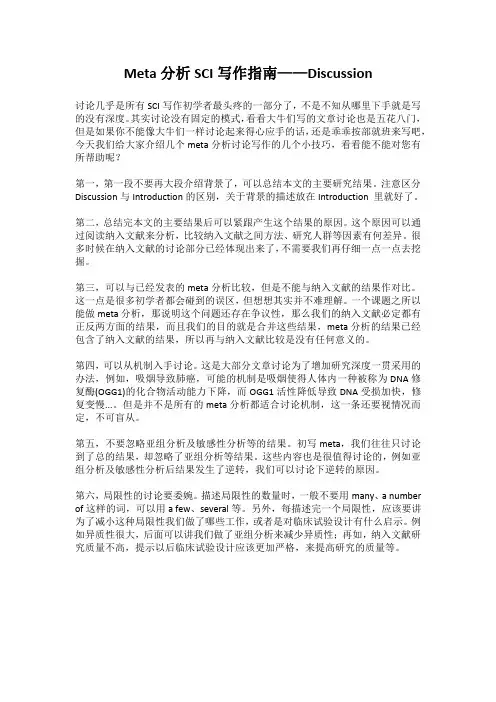
Meta分析SCI写作指南——Discussion讨论几乎是所有SCI写作初学者最头疼的一部分了,不是不知从哪里下手就是写的没有深度。
其实讨论没有固定的模式,看看大牛们写的文章讨论也是五花八门,但是如果你不能像大牛们一样讨论起来得心应手的话,还是乖乖按部就班来写吧,今天我们给大家介绍几个meta分析讨论写作的几个小技巧,看看能不能对您有所帮助呢?第一,第一段不要再大段介绍背景了,可以总结本文的主要研究结果。
注意区分Discussion与Introduction的区别,关于背景的描述放在Introduction里就好了。
第二,总结完本文的主要结果后可以紧跟产生这个结果的原因。
这个原因可以通过阅读纳入文献来分析,比较纳入文献之间方法、研究人群等因素有何差异。
很多时候在纳入文献的讨论部分已经体现出来了,不需要我们再仔细一点一点去挖掘。
第三,可以与已经发表的meta分析比较,但是不能与纳入文献的结果作对比。
这一点是很多初学者都会碰到的误区,但想想其实并不难理解。
一个课题之所以能做meta分析,那说明这个问题还存在争议性,那么我们的纳入文献必定都有正反两方面的结果,而且我们的目的就是合并这些结果,meta分析的结果已经包含了纳入文献的结果,所以再与纳入文献比较是没有任何意义的。
第四,可以从机制入手讨论。
这是大部分文章讨论为了增加研究深度一贯采用的办法,例如,吸烟导致肺癌,可能的机制是吸烟使得人体内一种被称为DNA修复酶(OGG1)的化合物活动能力下降,而OGG1活性降低导致DNA受损加快,修复变慢...。
但是并不是所有的meta分析都适合讨论机制,这一条还要视情况而定,不可盲从。
第五,不要忽略亚组分析及敏感性分析等的结果。
初写meta,我们往往只讨论到了总的结果,却忽略了亚组分析等结果。
这些内容也是很值得讨论的,例如亚组分析及敏感性分析后结果发生了逆转,我们可以讨论下逆转的原因。
第六,局限性的讨论要委婉。
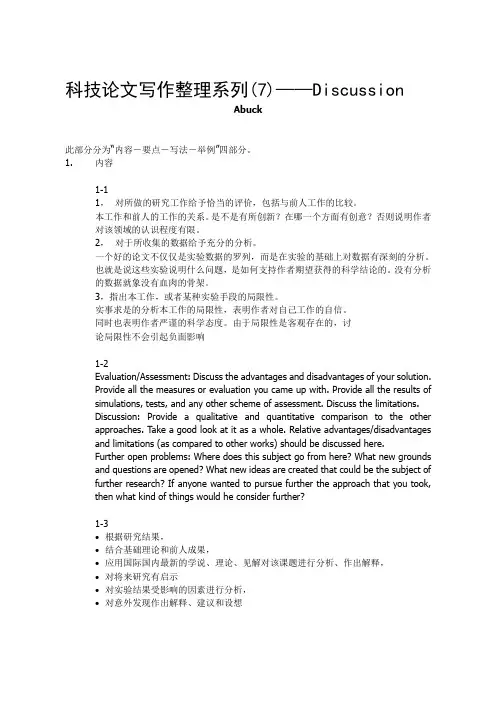
科技论文写作整理系列(7)——DiscussionAbuck此部分分为―内容-要点-写法-举例‖四部分。
1.内容1-11,对所做的研究工作给予恰当的评价,包括与前人工作的比较。
本工作和前人的工作的关系。
是不是有所创新?在哪一个方面有创意?否则说明作者对该领域的认识程度有限。
2,对于所收集的数据给予充分的分析。
一个好的论文不仅仅是实验数据的罗列,而是在实验的基础上对数据有深刻的分析。
也就是说这些实验说明什么问题,是如何支持作者期望获得的科学结论的。
没有分析的数据就象没有血肉的骨架。
3,指出本工作,或者某种实验手段的局限性。
实事求是的分析本工作的局限性,表明作者对自己工作的自信。
同时也表明作者严谨的科学态度。
由于局限性是客观存在的,讨论局限性不会引起负面影响1-2Evaluation/Assessment: Discuss the advantages and disadvantages of your solution.Provide all the measures or evaluation you came up with. Provide all the results of simulations, tests, and any other scheme of assessment. Discuss the limitations.Discussion: Provide a qualitative and quantitative comparison to the other approaches. Take a good look at it as a whole. Relative advantages/disadvantages and limitations (as compared to other works) should be discussed here.Further open problems: Where does this subject go from here? What new grounds and questions are opened? What new ideas are created that could be the subject of further research? If anyone wanted to pursue further the approach that you took, then what kind of things would he consider further?1-3•根据研究结果,•结合基础理论和前人成果,•应用国际国内最新的学说、理论、见解对该课题进行分析、作出解释,•对将来研究有启示•对实验结果受影响的因素进行分析,•对意外发现作出解释、建议和设想1-4⑴背景材料:展开问题的提出;有关本研究的一些基本知识内容(不要离题太远)⑵本实验结果分析:各指标的意义(与文献值比较),结果说明什么问题⑶进一步对结果机理分析:结合文献⑷本工作的意义、结语或小结,进一步提出的新问题1-5I. Discussion (Comment)1. Purpose: to explain the nature and importance of the findings (Answers the questions: "So what?" and "Who cares?")2. Should be the most useful section but is often the weakest3. Begins by summarizing the study and the main results.4. Discusses the implication of the results and what else is known about the problem and its proposed solutions5. Generally includes the literature review6. State the limitations of the study7. List the conclusionsa. Distinguish between clinical and statistical significanceb. In studies with low statistical power, do not mistake inconclusive results for negative results ("absence of proof is not proof of absence")c. Distinguish between supported conclusions and speculation1-6结果和结论部分代表着文章的主要成就和贡献,论文有没有价值,值不值得读者阅读,主要取决于你所获得的结果和所得出的结论。

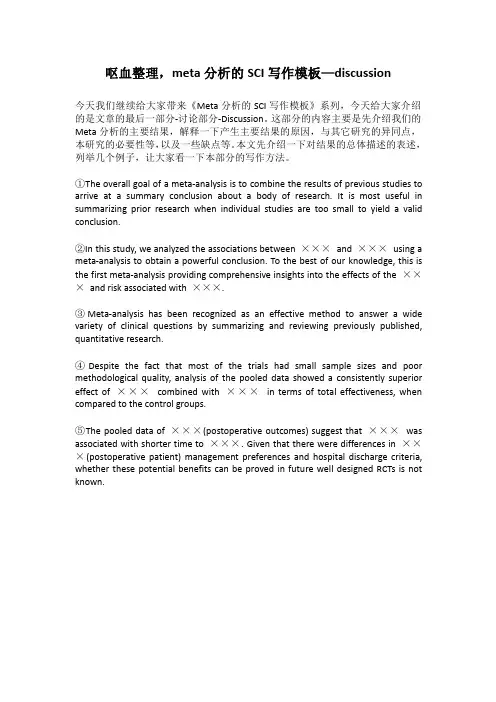
呕血整理,meta分析的SCI写作模板—discussion今天我们继续给大家带来《Meta分析的SCI写作模板》系列,今天给大家介绍的是文章的最后一部分-讨论部分-Discussion。
这部分的内容主要是先介绍我们的Meta分析的主要结果,解释一下产生主要结果的原因,与其它研究的异同点,本研究的必要性等,以及一些缺点等。
本文先介绍一下对结果的总体描述的表述,列举几个例子,让大家看一下本部分的写作方法。
①The overall goal of a meta-analysis is to combine the results of previous studies to arrive at a summary conclusion about a body of research.It is most useful in summarizing prior research when individual studies are too small to yield a valid conclusion.②In this study,we analyzed the associations between×××and×××using a meta-analysis to obtain a powerful conclusion.To the best of our knowledge,this is the first meta-analysis providing comprehensive insights into the effects of the×××and risk associated with×××.③Meta-analysis has been recognized as an effective method to answer a wide variety of clinical questions by summarizing and reviewing previously published, quantitative research.④Despite the fact that most of the trials had small sample sizes and poor methodological quality,analysis of the pooled data showed a consistently superior effect of×××combined with×××in terms of total effectiveness,when compared to the control groups.⑤The pooled data of×××(postoperative outcomes)suggest that×××was associated with shorter time to×××.Given that there were differences in×××(postoperative patient)management preferences and hospital discharge criteria, whether these potential benefits can be proved in future well designed RCTs is not known.。
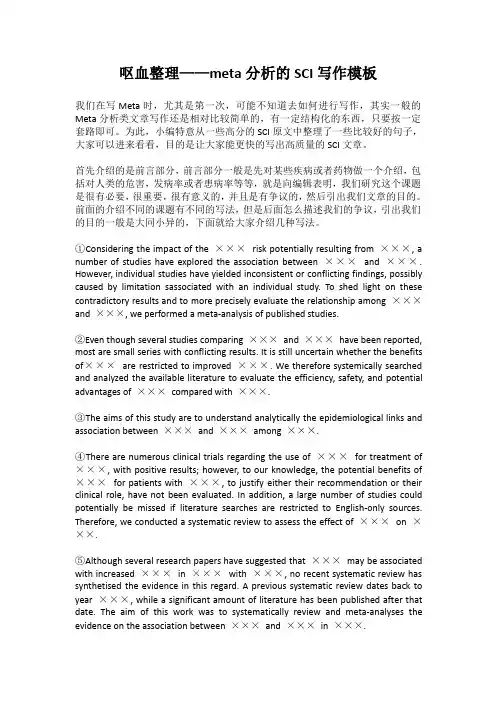
呕血整理——meta分析的SCI写作模板我们在写Meta时,尤其是第一次,可能不知道去如何进行写作,其实一般的Meta分析类文章写作还是相对比较简单的,有一定结构化的东西,只要按一定套路即可。
为此,小编特意从一些高分的SCI原文中整理了一些比较好的句子,大家可以进来看看,目的是让大家能更快的写出高质量的SCI文章。
首先介绍的是前言部分,前言部分一般是先对某些疾病或者药物做一个介绍,包括对人类的危害,发病率或者患病率等等,就是向编辑表明,我们研究这个课题是很有必要,很重要,很有意义的,并且是有争议的,然后引出我们文章的目的。
前面的介绍不同的课题有不同的写法,但是后面怎么描述我们的争议,引出我们的目的一般是大同小异的,下面就给大家介绍几种写法。
①Considering the impact of the×××risk potentially resulting from×××,a number of studies have explored the association between×××and×××. However,individual studies have yielded inconsistent or conflicting findings,possibly caused by limitation sassociated with an individual study.To shed light on these contradictory results and to more precisely evaluate the relationship among×××and×××,we performed a meta-analysis of published studies.②Even though several studies comparing×××and×××have been reported, most are small series with conflicting results.It is still uncertain whether the benefits of×××are restricted to improved×××.We therefore systemically searched and analyzed the available literature to evaluate the efficiency,safety,and potential advantages of×××compared with×××.③The aims of this study are to understand analytically the epidemiological links and association between×××and×××among×××.④There are numerous clinical trials regarding the use of×××for treatment of ×××,with positive results;however,to our knowledge,the potential benefits of ×××for patients with×××,to justify either their recommendation or their clinical role,have not been evaluated.In addition,a large number of studies could potentially be missed if literature searches are restricted to English-only sources. Therefore,we conducted a systematic review to assess the effect of×××on×××.⑤Although several research papers have suggested that×××may be associated with increased×××in×××with×××,no recent systematic review has synthetised the evidence in this regard.A previous systematic review dates back to year×××,while a significant amount of literature has been published after that date.The aim of this work was to systematically review and meta-analyses the evidence on the association between×××and×××in×××.。
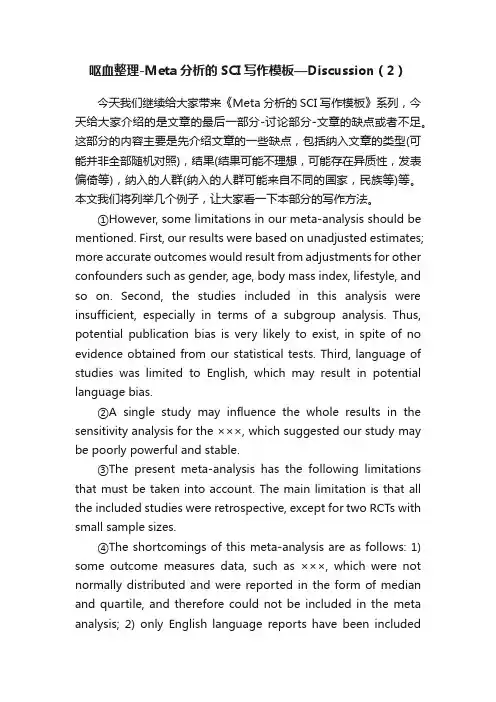
呕血整理-Meta分析的SCI写作模板—Discussion(2)今天我们继续给大家带来《Meta分析的SCI写作模板》系列,今天给大家介绍的是文章的最后一部分-讨论部分-文章的缺点或者不足。
这部分的内容主要是先介绍文章的一些缺点,包括纳入文章的类型(可能并非全部随机对照),结果(结果可能不理想,可能存在异质性,发表偏倚等),纳入的人群(纳入的人群可能来自不同的国家,民族等)等。
本文我们将列举几个例子,让大家看一下本部分的写作方法。
①However, some limitations in our meta-analysis should be mentioned. First, our results were based on unadjusted estimates; more accurate outcomes would result from adjustments for other confounders such as gender, age, body mass index, lifestyle, and so on. Second, the studies included in this analysis were insufficient, especially in terms of a subgroup analysis. Thus, potential publication bias is very likely to exist, in spite of no evidence obtained from our statistical tests. Third, language of studies was limited to English, which may result in potential language bias.②A single study may influence the whole results in the sensitivity analysis for the ×××, which suggested our study may be poorly powerful and stable.③The present meta-analysis has the following limitations that must be taken into account. The main limitation is that all the included studies were retrospective, except for two RCTs with small sample sizes.④The shortcomings of this meta-analysis are as follows: 1) some outcome measures data, such as ×××, which were not normally distributed and were reported in the form of median and quartile, and therefore could not be included in the meta analysis; 2) only English language reports have been includedand consequently we may have missing data from important studies published in other languages.。
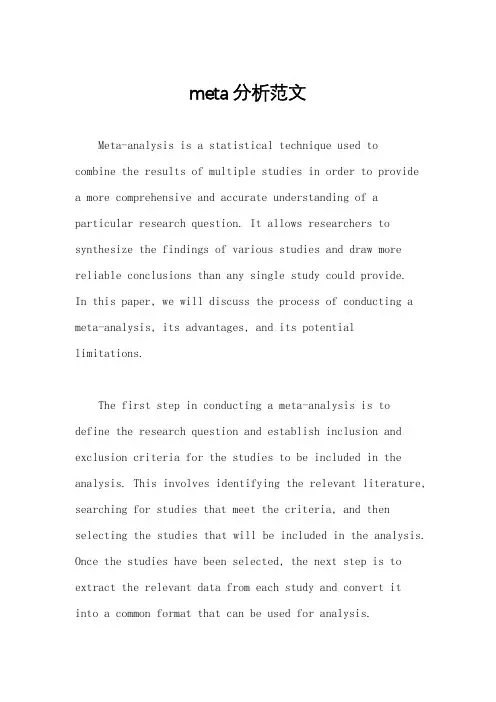
meta分析范文Meta-analysis is a statistical technique used to combine the results of multiple studies in order to provide a more comprehensive and accurate understanding of a particular research question. It allows researchers to synthesize the findings of various studies and draw more reliable conclusions than any single study could provide.In this paper, we will discuss the process of conducting a meta-analysis, its advantages, and its potentiallimitations.The first step in conducting a meta-analysis is todefine the research question and establish inclusion and exclusion criteria for the studies to be included in the analysis. This involves identifying the relevant literature, searching for studies that meet the criteria, and then selecting the studies that will be included in the analysis. Once the studies have been selected, the next step is to extract the relevant data from each study and convert itinto a common format that can be used for analysis.After the data has been extracted, the next step is to analyze the data using statistical techniques. Thistypically involves calculating effect sizes, which measure the strength of the relationship between variables, andthen combining the effect sizes from the individual studies to produce an overall estimate of the effect. This estimate can then be used to draw conclusions about the research question and to assess the overall strength of the evidence.One of the key advantages of meta-analysis is that it allows researchers to synthesize the findings of multiple studies, which can provide a more comprehensive andreliable understanding of a particular research question.By combining the results of multiple studies, researchers can increase the statistical power of their analysis and draw more reliable conclusions than any single study could provide. This can be particularly useful when individual studies have produced conflicting results, as meta-analysis can help to identify the sources of the discrepancies and provide a more accurate estimate of the true effect.Another advantage of meta-analysis is that it can help to identify patterns and trends that may not be apparent in individual studies. By combining the results of multiple studies, researchers can identify consistent findings and explore potential sources of variation across studies. This can help to generate new hypotheses and guide future research in the field.Despite its many advantages, meta-analysis also has some potential limitations that should be considered. One potential limitation is publication bias, which occurs when studies with positive results are more likely to be published than studies with negative results. This can lead to an overestimation of the true effect, as the published literature may not accurately reflect the full range of findings on a particular research question. To address this limitation, researchers can use statistical techniques such as funnel plots to assess the presence of publication bias and adjust their estimates accordingly.Another potential limitation of meta-analysis is the risk of including low-quality studies, which can bias theoverall estimate of the effect. To address this limitation, researchers can use inclusion criteria to select only high-quality studies for inclusion in the analysis and conduct sensitivity analyses to assess the robustness of their findings.In conclusion, meta-analysis is a powerful tool that can provide a more comprehensive and reliable understanding of a particular research question by synthesizing the findings of multiple studies. By combining the results of individual studies, researchers can increase thestatistical power of their analysis, identify patterns and trends, and draw more reliable conclusions than any single study could provide. However, it is important to consider the potential limitations of meta-analysis and take steps to address them in order to ensure the reliability and validity of the findings.。
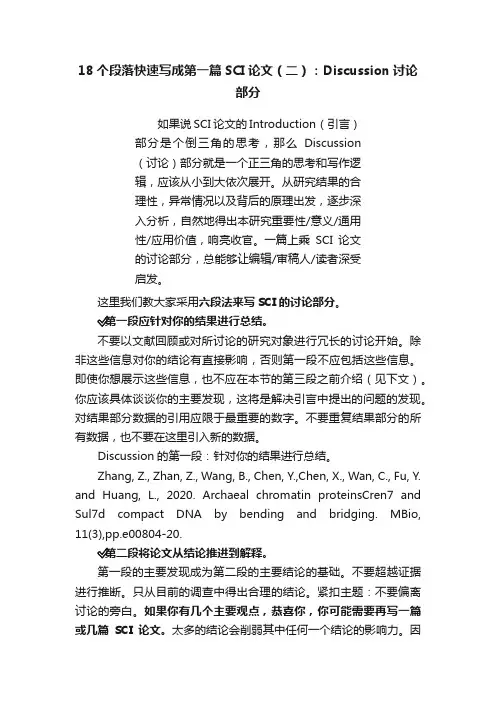
18个段落快速写成第一篇SCI论文(二):Discussion讨论部分如果说SCI论文的Introduction(引言)部分是个倒三角的思考,那么Discussion(讨论)部分就是一个正三角的思考和写作逻辑,应该从小到大依次展开。
从研究结果的合理性,异常情况以及背后的原理出发,逐步深入分析,自然地得出本研究重要性/意义/通用性/应用价值,响亮收官。
一篇上乘SCI论文的讨论部分,总能够让编辑/审稿人/读者深受启发。
这里我们教大家采用六段法来写SCI的讨论部分。
✅第一段应针对你的结果进行总结。
不要以文献回顾或对所讨论的研究对象进行冗长的讨论开始。
除非这些信息对你的结论有直接影响,否则第一段不应包括这些信息。
即使你想展示这些信息,也不应在本节的第三段之前介绍(见下文)。
你应该具体谈谈你的主要发现,这将是解决引言中提出的问题的发现。
对结果部分数据的引用应限于最重要的数字。
不要重复结果部分的所有数据,也不要在这里引入新的数据。
Discussion的第一段:针对你的结果进行总结。
Zhang, Z., Zhan, Z., Wang, B., Chen, Y.,Chen, X., Wan, C., Fu, Y. and Huang, L., 2020. Archaeal chromatin proteinsCren7 and Sul7d compact DNA by bending and bridging. MBio, 11(3),pp.e00804-20.✅第二段将论文从结论推进到解释。
第一段的主要发现成为第二段的主要结论的基础。
不要超越证据进行推断。
只从目前的调查中得出合理的结论。
紧扣主题:不要偏离讨论的旁白。
如果你有几个主要观点,恭喜你,你可能需要再写一篇或几篇SCI论文。
太多的结论会削弱其中任何一个结论的影响力。
因此,最好是写集中而紧凑的论文,而不是写一篇全面但分散的大作。
✅第三段应说明你的解释是否与其他研究人员的解释一致。
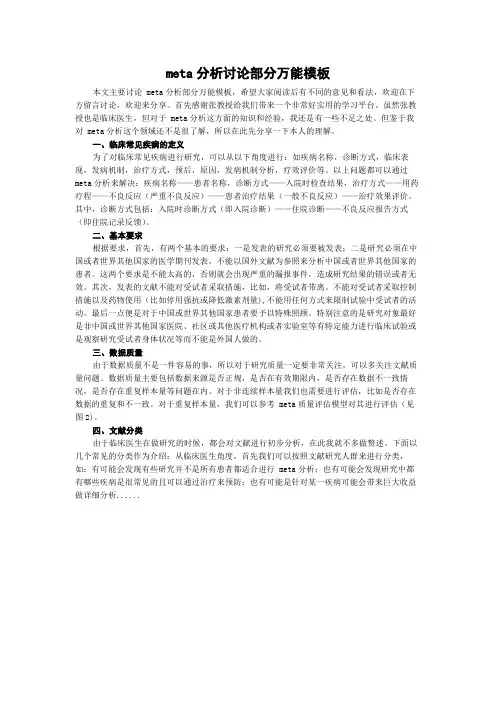
meta分析讨论部分万能模板本文主要讨论 meta分析部分万能模板,希望大家阅读后有不同的意见和看法,欢迎在下方留言讨论,欢迎来分享。
首先感谢张教授给我们带来一个非常好实用的学习平台。
虽然张教授也是临床医生,但对于 meta分析这方面的知识和经验,我还是有一些不足之处。
但鉴于我对 meta分析这个领域还不是很了解,所以在此先分享一下本人的理解。
一、临床常见疾病的定义为了对临床常见疾病进行研究,可以从以下角度进行:如疾病名称,诊断方式,临床表现,发病机制,治疗方式,预后,原因,发病机制分析,疗效评价等。
以上问题都可以通过meta分析来解决:疾病名称——患者名称,诊断方式——入院时检查结果,治疗方式——用药疗程——不良反应(严重不良反应)——患者治疗结果(一般不良反应)——治疗效果评价。
其中,诊断方式包括:入院时诊断方式(即入院诊断)——住院诊断——不良反应报告方式(即住院记录反馈)。
二、基本要求根据要求,首先,有两个基本的要求:一是发表的研究必须要被发表;二是研究必须在中国或者世界其他国家的医学期刊发表,不能以国外文献为参照来分析中国或者世界其他国家的患者。
这两个要求是不能太高的,否则就会出现严重的漏报事件,造成研究结果的错误或者无效。
其次,发表的文献不能对受试者采取措施,比如,将受试者带离。
不能对受试者采取控制措施以及药物使用(比如停用强抗或降低激素剂量),不能用任何方式来限制试验中受试者的活动。
最后一点便是对于中国或世界其他国家患者要予以特殊照顾。
特别注意的是研究对象最好是非中国或世界其他国家医院、社区或其他医疗机构或者实验室等有特定能力进行临床试验或是观察研究受试者身体状况等而不能是外国人做的。
三、数据质量由于数据质量不是一件容易的事,所以对于研究质量一定要非常关注,可以多关注文献质量问题。
数据质量主要包括数据来源是否正规,是否在有效期限内,是否存在数据不一致情况,是否存在重复样本量等问题在内。
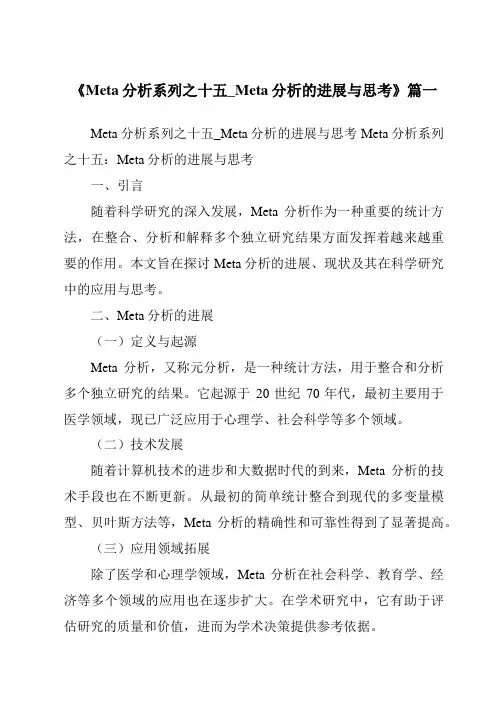
《Meta分析系列之十五_Meta分析的进展与思考》篇一Meta分析系列之十五_Meta分析的进展与思考Meta分析系列之十五:Meta分析的进展与思考一、引言随着科学研究的深入发展,Meta分析作为一种重要的统计方法,在整合、分析和解释多个独立研究结果方面发挥着越来越重要的作用。
本文旨在探讨Meta分析的进展、现状及其在科学研究中的应用与思考。
二、Meta分析的进展(一)定义与起源Meta分析,又称元分析,是一种统计方法,用于整合和分析多个独立研究的结果。
它起源于20世纪70年代,最初主要用于医学领域,现已广泛应用于心理学、社会科学等多个领域。
(二)技术发展随着计算机技术的进步和大数据时代的到来,Meta分析的技术手段也在不断更新。
从最初的简单统计整合到现代的多变量模型、贝叶斯方法等,Meta分析的精确性和可靠性得到了显著提高。
(三)应用领域拓展除了医学和心理学领域,Meta分析在社会科学、教育学、经济等多个领域的应用也在逐步扩大。
在学术研究中,它有助于评估研究的质量和价值,进而为学术决策提供参考依据。
三、Meta分析在科学研究中的应用与思考(一)在文献综述中的作用Meta分析有助于提高文献综述的准确性。
通过整合多个独立研究的结果,我们可以更全面地了解某一研究领域的现状和趋势,从而为决策提供有力的依据。
(二)对科学研究的启示1. 验证研究假设:通过Meta分析,我们可以验证之前的研究假设是否成立,从而为新的研究提供方向。
2. 评估研究质量:通过整合多个研究的结果,我们可以对单个研究的质量进行评估,进而提高整个研究领域的水平。
3. 优化研究设计:根据Meta分析的结果,我们可以对现有的研究设计进行优化,以提高研究的效率和准确性。
(三)思考与展望虽然Meta分析在科学研究中发挥了重要作用,但仍存在一些局限性。
例如,如何选择合适的统计方法和模型、如何处理异质性等问题仍需进一步研究和探讨。
此外,随着大数据时代的到来,如何利用Meta分析对海量数据进行有效整合和分析也是一个重要的研究方向。
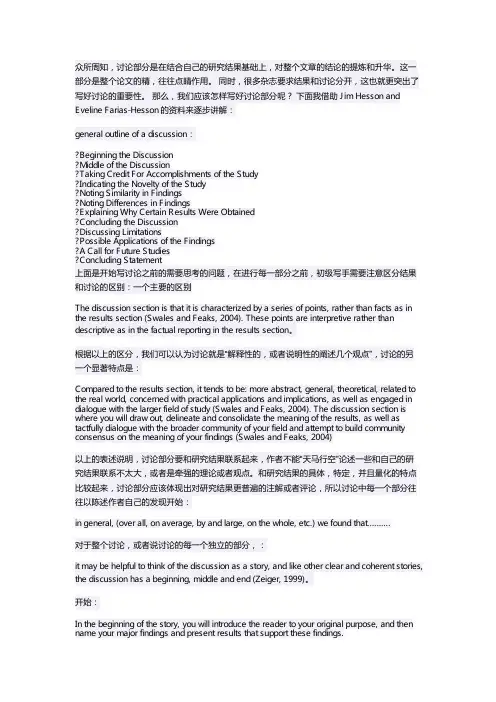
众所周知,讨论部分是在结合自己的研究结果基础上,对整个文章的结论的提炼和升华。
这一部分是整个论文的精,往往点睛作用。
同时,很多杂志要求结果和讨论分开,这也就更突出了写好讨论的重要性。
那么,我们应该怎样写好讨论部分呢?下面我借助Jim Hesson and Eveline Farias-Hesson的资料来逐步讲解:general outline of a discussion:?Beginning the Discussion?Middle of the Discussion?Taking Credit For Accomplishments of the Study?Indicating the Novelty of the Study?Noting Similarity in Findings?Noting Differences in Findings?Explaining Why Certain Results Were Obtained?Concluding the Discussion?Discussing Limitations?Possible Applications of the Findings?A Call for Future Studies?Concluding Statement上面是开始写讨论之前的需要思考的问题,在进行每一部分之前,初级写手需要注意区分结果和讨论的区别:一个主要的区别The discussion section is that it is characterized by a series of points, rather than facts as in the results section (Swales and Feaks, 2004). These points are interpretive rather than descriptive as in the factual reporting in the results section。
Meta分析讨论写作要点关于一般SCI论文的讨论部分如何写作有许多大道理,但听了许多大道理,却仍写不好分析讨论。
meta分析的讨论与原始研究文章一样,常规需要解释结果、提出优缺点及临床意义,但又与这些文章不同,在分析讨论部分有些自己的特点。
作为文章的精髓,讨论部分的好坏在文章发表中占据了非常重要的作用。
下面以一篇发表在the Lancet 上的文章[1]的讨论部分为例,讲解Meta分析讨论部分的写作要点。
明确提出本研究的主要发现:在引言部分,许多文章会利用picos原则提出本研究做了哪些工作。
讨论部分应该与这句话相呼应,明确提出本研究的主要发现,分析主要结果的临床意义,本研究结果的适用人群及地区范围。
另外,异质性分析、亚组分析的结果也应讨论,几个结果可分为几个小段,它们之前是平行或递进的关系。
举例该文章提及的引言主要有以下几个问题:whether blood pressure lowering treatment reduces the risk of cardiovascular disease in all patient populations remains unclear.人群中降低血压是否能减少心血管事件的风险。
结论的第一句话就呼应引言,给出答案:In this meta-analysis, blood pressure lowering treatment significantly reduced the risk of cardiovascular disease and death in various populations of patients.是的,可以降低心血管事件及死亡的风险。
引证总结证据,分析与本研究结果的异同:引言部分一般会引用已有的系统评价、meta分析、指南及专家共识、纳入文献指出本研究问题的富有争议的主本人系天天论文网就职11年的资深论文编辑;工作中与各大医学期刊杂志社进行学术交流过程中建立了稳定的编辑朋友圈,系多家医学杂志社的特约编辑,常年为医学期刊杂志供稿,负责天天论文网医学论文·分检·编校·推送·指导等工作!工作企鹅1:1550116010工作企鹅2:766085044要观点,而在讨论部分,与前言类似,但更详细,也不可以重复,不需再与纳入文献的结果作对比。
医学mate分析范文一、前言。
大家好!今天咱们来唠唠关于[具体疾病名称]的那些事儿。
你说这病吧,就像个小恶魔,老是折腾患者。
不过呢,现在医学上有好几种治疗方法,可到底哪种最有效呢?这就像在一堆宝藏里找最闪亮的那颗钻石一样,得好好研究研究。
所以呢,咱们就来做个Meta分析,把那些关于这些治疗方法的研究都汇总汇总,看看能不能得出个靠谱的结论。
二、资料与方法。
# (一)资料来源。
咱就像个小侦探一样,在各大医学数据库里搜索相关的研究。
像PubMed、Web of Science、知网这些地方,都被我们翻了个遍。
搜索的关键词就是[疾病名称]和各种相关的治疗方法,比如说[治疗方法1]、[治疗方法2]之类的。
# (二)纳入与排除标准。
这就像是在挑选参赛选手一样。
纳入的研究得是专门针对[具体疾病名称]的,而且得明确提到使用了我们感兴趣的那些治疗方法,还得有一些关键的数据,像治疗后的有效率啊、不良反应这些。
那排除的呢,就是那些数据不全的,或者研究质量特别差的,就像那些没好好准备就来参赛的选手,可不能要。
# (三)数据提取与质量评价。
从那些入选的研究里提取数据可不容易,就像从一堆乱麻里抽出有用的线一样。
我们得仔细地把每个研究里关于患者的基本情况、治疗方法的具体细节、治疗效果这些数据都找出来。
然后呢,还要对这些研究的质量进行评价。
这就好比是给选手打分,看看这个研究设计得合理不合理,有没有什么漏洞。
我们用的是[具体的质量评价工具]来打分的。
三、结果。
# (一)研究的基本情况。
经过一番搜索和筛选,我们总共找到了[X]项研究符合要求。
这些研究来自不同的国家和地区,就像世界各地的小伙伴都来参加这个关于[具体疾病名称]治疗的大讨论一样。
患者的年龄啊、性别啊、病情严重程度这些也都有一定的差异。
# (二)治疗效果的Meta分析。
1. [治疗方法1]咱们先来看[治疗方法1]。
把这些使用[治疗方法1]的研究数据汇总起来分析,发现它的总体有效率大概是[X]%。
SCI论文写作模板
科学论文写作模板通常遵循以下结构:
1.标题:简明扼要地反映研究内容
2.摘要:简短地总结研究目的、方法、结果和结论
3.引言:介绍研究领域的背景,提出研究问题,概述已有研究和知识之间的差距,明确研究目标和意义
4.方法:详细描述研究设计、实验设备和材料,并解释如何收集、分析和解释数据
6.讨论:对结果进行解释,分析所得结果与研究目标之间的关联,指出研究的局限性并提出未来研究的方向
7.结论:总结整篇论文的主要发现和结论,强调对研究领域的意义和可能的应用
下面是一个简化的SCI论文写作模板:
标题:[Title]
摘要:[Abstract]
引言:[Introduction]
方法:[Methods]
结果:[Results]
讨论:[Discussion]
结论:[Conclusion]
请注意,根据不同的领域和期刊要求,模板的具体内容和组织结构可能会有所不同。
因此,在使用模板之前,请确保仔细阅读目标期刊的投稿指南,并根据其要求进行相应的调整。
此外,除了标题和摘要外,其他节的字数可能需要根据期刊的要求进行调整,通常要求在1200字以上。
SCI写作中Discussion部分怎么写?-美辑编译Discussion,讨论。
在一篇SCI中仅占篇幅不多的一个部分,却有着升华主题,提升文章高度的重要作用。
但如何才能使得一篇SCI的讨论具有升华主题的作用呢?那么,你需要了解这部分的内容怎么写?A.讨论部分包括什么内容?(1)主要数据及其特征的总结;(2)主要结论及与前人观点的对比;(3) 本文的不足。
对第三点,一般作者看来不可取,但事实上给出文章的不足恰恰是保护自己文章的重要手段。
如果刻意隐藏文章的漏洞,觉得别人看不出来,是非常不明智的。
所谓不足,包括以下内容:(1)研究的问题有点片面,讨论时一定要说,It should be noted that this study has examined only……We concentrate (focus) on only……We have to point out that we do not……Some limitations of this study are……(2)结论有些不足,The results do not imply……The results can not be used to determine(or be taken as evidence of)……Unfortunately, we can not determine this from this data……Our results are lack of……但指出这些不足之后,一定要马上再次加强本文的重要性以及可能采取的手段来解决这些不足,为别人或者自己的下一步研究打下伏笔。
Not withstanding its limitation, this study does sugges t……However, these problems could be solved if we consider……Despite its preliminary character, this study can clearly indicate……用中文来说这是左右逢源,把审稿人想到的问题提前给一个交代,同时表明你已经在思考这些问题,但是由于文章长度,试验进度或者试验手段的制约,暂时不能回答这些问题。
论⽂中最见功底的Discussion应该这样写!讨论部分引导审稿⼈得当,就会凸显研究的价值,即使是阴性结果,如果你能⾃圆其说,也是能化腐朽为神奇的,此类例⼦举不胜举。
所以讨论部分的写法技巧尤为重要今天就和孙学军⽼师⼀起了解⼀下,论⽂中最重要的discussion部分到底应该怎么写呢?Part1 撰写论⽂需要注意的事项 论⽂写作上,许多⽜⼈都给出了各⾃的经验,我虽然发表过许多论⽂,但是真正⾃⼰写的并不多,所以也⽆所谓有价值的经验,尤其是英⽂的基础⼗分不够,看看论⽂找点⽑病的尚可应付,真的让我写篇论⽂,感觉仍然是⾮常痛苦的⼯作。
不过写论⽂我觉得⾸先要在战略上藐视。
⾸先我们知道写论⽂不是写作⽂,⼀般可以有⽐较充分⾜够的时间,也就是说论⽂可以慢慢磨,慢慢修改;论⽂属于应⽤⽂,不是⽂艺创造,本质上只要将问题讲清楚,分析清楚,就可以满⾜需要;论⽂是⼋股⽂,每个部分都有⼤概的框架结构,⼜有⼤量其他学者发表的论⽂作为参考,如果把论⽂的各个部分分解开,就相对⽐较容易克服了。
后⾯是⼀家论⽂修改公司转发的资料,我觉得⾮常不错,放这⾥给⼤家参考(见part2)。
Part2 论⽂各部分写作指导1. Abstract 整体要求简练,⾔简意赅,因为绝⼤部分journal对Abstract都有字数限制,⼀般150~250 words. 先简单描述⼀下⾃⼰⼯作的前沿背景,⼏句话,然后引出⾃⼰的实验(“In this paper...”;“Here in...” or “Here, we...”),主要陈述实验结果,可稍带提⼀下所⽤到的重要⽅法的名称,然后说明你的结果的意义“These data suggest...”;最后总结拔⾼“In a word, ...”or “In summary, ...”。
2. Introduction 描述跟你的实验相关的领域研究现状及存在的问题,⾃然地过度到你实验的意义和重要性。
“Although..., there are still...so far...”“Here, for the first time, we have used...”。
Meta分析的SCI写作模板—Discussion
文章的最后一部分-讨论部分-Discussion。
这部分的内容主要是先介绍我们的Meta分析的主要结果,解释一下产生主要结果的原因,与其它研究的异同点,
本研究的必要性等,以及一些缺点等。
本文先介绍一下对结果的总体描述的表述,列举几个例子,让大家看一下本部分的写作方法。
①The overall goal of a meta-analysis is to combine the results of previous studies to arrive at a summary conclusion about a body of research. It is most useful in summarizing prior research when individual studies are too small to yield a valid conclusion.
②In this study, we analyzed the associations between ×××and ×××using a meta-analysis to obtain a powerful conclusion. To the best of our knowledge, this is the first meta-analysis providing comprehensive insights into the effects of the ×××and risk associated with ×××.
③Meta-analysis has been recognized as an effective method to answer a wide variety of clinical questions by summarizing and reviewing previously published, quantitative research.
④Despite the fact that most of the trials had small sample sizes and poor methodological quality, analysis of the pooled data showed a consistently superior effect of ×××combined with ×××in terms of total effectiveness, when compared to the control groups.
⑤The pooled data of ×××(postoperative outcomes) suggest that ×××was associated with shorter time to ×××. Given that there were differences in ×××(postoperative patient) management preferences and hospital discharge criteria, whether these potential benefits can be proved in future well designed RCTs is not known.。